by Winding Pathways | May 30, 2024 | (Sub)Urban Homesteading, Mammals, Pests
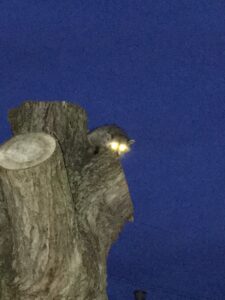
Raccoons are strong and hungry.
A raccoon kerfluffle with loud growling and snarling startled us to nearly jump from our chairs one May evening. It came from an oak tree 20 feet away from the house and close to our bird feeder. A flashlight beam on that pitch-black night revealed the culprits – three young raccoons high in the tree.
They quickly scurried down the tree and scampered out of flashlight range, letting us return to reading. Why was there a young raccoon kerfluffle? We can only guess but we’re certain they were there because of our nearby bird feeder.
What Raccoons Eat
At first glance, raccoons seem to be carnivores. They have sharp meat-eating teeth and look somewhat like a cross between a dog and a cat. Looks are deceiving. Raccoons are amazingly abundant across much of North America, in large part because they are opportunistic omnivores that seem eager to eat almost anything. They love frogs, crayfish, mussels, earthworms, fish, and any unfortunate mouse or vole they can catch. To a raccoon, a garbage can or dumpster is an invitation to dinner where they might discover delicious pizza crusts and an array of other discarded goodies.
Not Just Birds at the Feeder
Raccoons love fruit and grains. We have them in abundance. That is what lured them to our yard. To these cute but powerful animals, a feeder is an after-dark cafe. Most everyone is familiar with the determination squirrels show when attempting to reach even the most inaccessible feeder. Squirrels work feeders on the day shift while raccoons, deer, mice, voles,
skunks, opossums, bears, and flying squirrels often visit after dark when few people are watching.
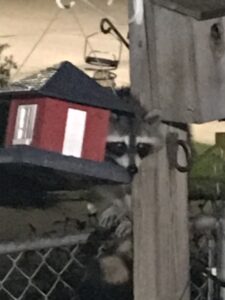
Raccoons are skillful climbers.
At Winding Pathways, we put expensive sunflower seeds in a feeder suspended by a metal hook on a slippery metal pole. It is so high even deer can’t reach it. But since many birds prefer feeding on the ground, we sprinkle cracked corn, millet, and a few sunflower seeds on the ground beneath the high feeder.
Usually, birds clean up all the seeds by sunset, but frequently some remain as darkness approaches. It’s always gone the next morning. Nocturnal mammals did the clean-up work.
After Dark Feeder Watching
Once in a while, we focus a flashlight beam on the feeder after dark. Often the eyes of deer glow back at us, and occasionally we spot other animals enjoying a seed dinner. Usually visiting raccoons eat quietly, but the startling noise we heard that night came from squabbling youngsters.
Adaptable Raccoons
Raccoons are amazingly adaptable. Our son lives in one of the most densely populated cities in the world – Brooklyn, NY. He occasionally sees a raccoon sticking its head up from a dumpster.
They are not just in North America. Raccoons were introduced to Russia to create a fur resource. They also were released in 1934 in Germany and have since spread far and wide and are increasingly common in Ukraine. Many Japanese people imported baby raccoons as pets and released some as they grew large and unruly. Today wild raccoons range through much of that Asian country.
Whether in Russia, Ukraine, or Japan they are exotic, invasive animals causing mischief. Although common in the United States they are native here and sometimes create a mess as they paw through a trash can or raid a chicken coop. However, they’re fascinating and beautiful animals that can often be spotted beneath a feeder in a flashlight beam.
The Nature Conservancy posts an excellent blog called “Seven US Species Invading Other Countries.” Raccoons top the list.
Nightly Adventure Continues
Since that evening, the trio of masked bandits that caused a raccoon kerfuffle have returned. Sometimes, like any siblings, they get along. Other times they disturb the night as they screech, snarl, and growl at each other until we shine a light on them or shoo them off. We can always count on some nocturnal adventure at Winding Pathways.
by Winding Pathways | Apr 4, 2024 | (Sub)Urban Homesteading, Garden/Yard, Pests
Easy Peasy Life for Ticks
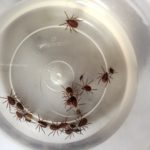
Collection of ticks
The recent warm winter was easy on heating bills and back muscles used to shovel snow, but it may mark an early return of Lyme Disease and the ticks that spread it.
At Winding Pathways we take a multi-pronged approach to reducing the odds of being bitten by an infected tick. Here’s great news! A new way to reduce Lyme Disease in white-footed mice is emerging which is good news for human health.
It was once believed that whitetail deer were the primary carriers of Lyme Disease with the theory that an infected tick leaves a deer and bites a human. Deer can carry Lyme Disease and pets and other wild animals can get it, but new research shows that white-footed (or deer) mice are the major carrier. Those tiny rodents are abundant where people live.
Old Standby Ways To Protect Against Lyme Disease
For many years we’ve done several things to lessen the chance that an infected tick will bite us.
First, we use repellents, even when working in the garden or enjoying a backyard barbeque. Deet-based repellents are widely available and repel ticks, mosquitoes, and even pesky flies. Deet can be applied to the skin. Permethrin is fatal to ticks and shouldn’t be applied to the skin. Spraying it on clothing makes life challenging for any tick seeking a human blood meal.
In recent years we’ve bought clothing from the Insect Shield Company. It is permeated with permethrin. Their clothing is stylish, comfortable, and durable, so we invested in several sets. In winter those clothes are stowed in the attic but worn daily during months when ticks are on the prowl.
Permethrin is sold in spray containers and it’s easy to treat jeans, shirts, socks, and shoes without needing to buy specially treated clothing. The chemical remains in clothing through several washings.
Second, we always do a tick check after being outside. Ticks typically walk around on a person for a few hours seeking a warm spot with thin skin to best extract blood. An unattached tick won’t spread disease, so after being outside we shed clothes, put them in the washing machine, take a warm sudsy shower, and check our bodies for ticks. They’re most likely to lurk in warm moist body parts but can be anywhere.
-

-
Pants, boots, varied sprays can reduce odds of picking up ticks
-
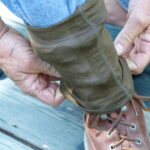
-
gaiters with tick guard helps repel ticks.
-

-
Pants, shirts, and socks infused with permethrin appear to keep ticks off.
New Promising Way to Reduce Lyme Disease
Relatively new research links the incidence of Lyme Disease with the presence of white-footed mice. Before we knew this we were already doing the right thing by encouraging mouse predators to live on our property. We love spotting hawks wheel overhead and hearing the chilling calls of nighttime owls. Both feast on mice. So do foxes, many snake species, and coyotes. Domestic cats also do but they kill many birds, so we are a catless family.
US Biologic is introducing a new way to reduce the odds a human will contract Lyme Disease from a tick that had bitten an infected mouse. They’ve been working on its development for 20 years, and it’s becoming available through pest control companies in many states.
Lyme Shield
It’s called the LymeShield System which combines traditional tick control with Lyme vaccine-coated pellets in a timed application dispenser. It doesn’t kill the mouse or any predator that might catch and eat it. A tick that bites an inoculated mouse will not pick up the Lyme bacteria. So, if that tick then bites a human it will not transfer the disease. The home page has a fascinating map that shows the progressive spread of Lyme disease.
US Biologic has come up with a clever way to help protect a family from Lyme Disease. We’re going to try it when it’s available in Iowa but we’ll keep using Deet and Pyrethrin and doing tick checks after being outside. We’ll also keep saying “thanks” to our predator neighbors that are constantly on the prowl for mice meals.
Being outdoors is amazingly good for human health. Playing ball, fishing, gardening, grilling, and even just sitting in a lawn chair offer healthy fresh air and sunshine. Fear of contracting Lyme Disease encouraged many people to stay indoors. Winding Pathways urges them to take tick precautions but spend as much time as possible outside.
Go outside and have fun.
by Winding Pathways | Feb 22, 2024 | Birds, Mammals, Nature, Pests
We’ve blogged before about a white-footed mouse in the house. We read the story to our kids when they were little. Time after time we snuggled down with the book and they never got tired of hearing why the mouse might be cute but doesn’t belong in the house. A recent internet search for the specific book revealed lots of stories but not the one we wanted. Alas. So, here we are decades later writing again about a mouse in the house. Mice are cute but they do not belong in a house.
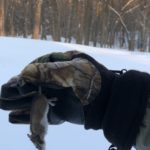
A person holding a mouse.
Whenever we’d find mouse evidence in our house, we’d set traps and usually catch a few, tossing their lifeless bodies outside for scavenger animals to eat. We do feel badly, but as the mother in the story said, “…a mouse does not belong in a house.”
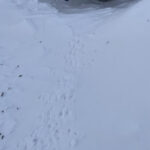
Path to the outdoor pantry
In January we changed our mind…..sort of. It was 20 below zero outside. Rich trudged through snow drifts to fill our bird feeders and noticed tracks, tiny mouse tracks, in the snow. A crafty white-footed mouse had scampered on top of the snow the night before to scrounge a few leftover seeds for dinner. Its tracks led to a snug nook out of the wind and under the deck.
An average White-footed mouse weighs a whopping .7 ounce. That’s seven-tenths of an ounce! That such a tiny creature can survive the howling wind and intense cold is a marvel of nature. Every nocturnal predator from coyotes to owls tries to capture and eat this diminutive mammal. But, it is wily, wary, and quick. Although not usually out during the day, it has to be mindful of cats and hawks looking for a meal.
-
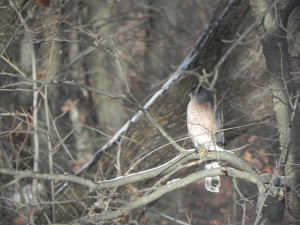
-
Patience
-
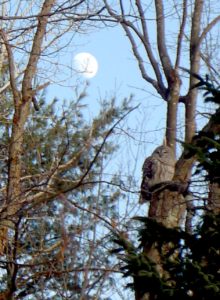
-
Nocturnal predator
After seeing those tracks, we felt a bit sorry for the animal that made them. We still won’t welcome a mouse into our house, but we’re happy it lives just outside in a safe place under the deck. He’s welcome to any seeds the birds overlooked.
To learn more about White Footed Mice and many other wild animals check out Animal Diversity Web out of the University of Michigan.
by Winding Pathways | Jan 18, 2024 | (Sub)Urban Homesteading, Birds, Nature, Pests
Frustration Yields to Creativity
Reprising the blog on thwarting House Sparrows. Here is a recap of our initial frustration and subsequent ways to encourage native birds and discourage exotics.
As we wrote earlier, hordes of House Sparrows almost made us give up feeding birds. We’d fill our feeders each morning and hope to watch juncos, cardinals, chickadees, woodpeckers, and nuthatches visit on cold winter days. Unfortunately, hordes of House Sparrows began arriving. We don’t mind feeding a few, but dozens soon devoured all the expensive seed, leaving empty feeders for native species.
Coming Up Short on “Expert Advice”
We asked bird experts what we might do to discourage House Sparrows and tried several of their ideas. Nothing worked well, so we experimented and came up with a few tricks that seem to discourage House Sparrows to a degree yet let other species eat. Our tricks aren’t perfect and sparrows still come, but not in huge numbers.
Here’s what we did:
Altered filling time:
We noticed that cardinals, jays, chickadees, and nuthatches visited feeders in the early morning and late afternoon, but House Sparrows came more late morning and toward the middle of the day. So, we put out small amounts of seeds early in the morning and again in late afternoon. Often our feeders are empty mid-day when the house sparrows prefer to visit.
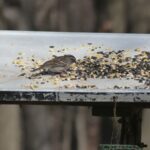
Eating from platform feeder
Sparrows enjoy feeding on the ground, on horizontal tables and other flat surfaces, and from silo-type feeders with long perches and large openings. We took down our standard silo feeders and replaced them with a silo shape feeder made of hardware cloth with a quarter-inch mesh.
In our quarter-inch mesh feeder, we put a mixture of black oil sunflower seeds and hulled peanuts. Native birds seemed better able to extract the sunflower from the mesh than House Sparrows. The peanuts don’t fit through the mesh, but many native bird species peck at them through the wire and extract pieces of peanuts. House Sparrows seem less able, or willing, to do this.
We also stopped feeding cracked corn and millet on the ground. Sparrows love them. Instead, we now toss full kernels of corn on the ground. Sparrows can’t swallow the big seeds and are unable to peck them apart. Woodpeckers, cardinals, blue jays, and nuthatches swallow or carry away the big seeds.
Put up with some House Sparrows
Our system helps deter these pesky exotic birds but is far from perfect. House Sparrows still visit and eat seeds but not as many as before we started using these tricks. Maybe they’ll work for you.
A few of you have shared. Now Others Can Share.
Winding Pathways is eager to learn other ways to deter House Sparrows. If you have discovered something that works, please let us know.
#
by Marion Patterson | Dec 21, 2023 | Nature, Pests
House Sparrow Blues
One of our favorite Thanksgiving Day activities is enjoying a sumptuous meal while watching chickadees, nuthatches, cardinals, and woodpeckers enjoy the seeds we put out for them just outside our window.
Thanksgiving 2023 brought mostly frustration. Crowds of House Sparrows swarmed our feeders with hardly a native bird in sight. Formerly known as English Sparrows, there seem to be more of these pesky immigrants every year.
Strategies
We’re not alone. A common phone call or email that comes to Winding Pathways seeks ways to feed native birds and discourage hordes of House Sparrows. Over the years we’ve tried these things to discourage the hardy and prolific Eurasian birds:
- Putting only small amounts of feed out in the early morning and late afternoon when native birds visit and House Sparrows are mostly gone.
- Cutting silo feeder perches short to make it harder for the somewhat clumsy sparrows to perch and eat.
- Sprinkle some whole corn on the lawn. It’s too big for sparrows to eat but blue jays and woodpeckers devour it.
- Sprinkle cracked corn way out in the backyard to entice sparrows away from our main feeders.
- Eliminate sparrow nesting sites around our yard and pull out any nests that form under eaves or in tight spaces along the house.
Result
None of these has worked particularly well.
Others More Fortunate
While we are frustrated, other people are fortunate. We recently enjoyed watching a procession of native birds visiting Jody Vrieze’s feeders in a rural area near Charles City, Iowa. It’s along the Cedar River and away from town. Perhaps her home and yard are a key to avoiding sparrow numbers.
-
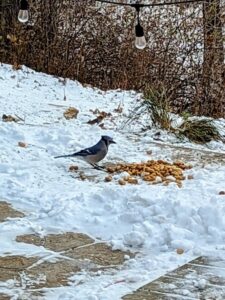
-
Jays swallow large nuts.
-
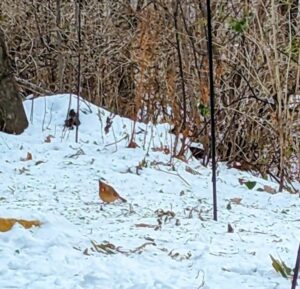
-
Cardinals enjoy eating on the ground.
-
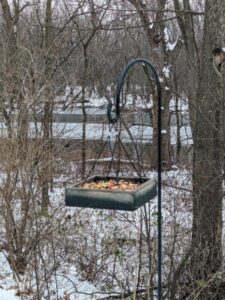
-
Woods attract native birds.
-
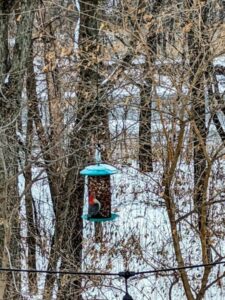
-
Many woodpeckers come to the feeders.
-
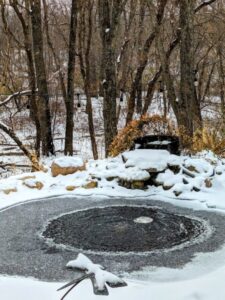
-
Open water is important for wildlife.
-
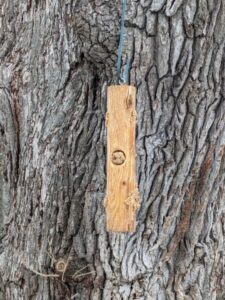
-
Peanut butter log.
What is a Synanthrope? How Do They Spread?
They are true synanthropes, meaning they need to live close to people. Backpack into a wilderness anywhere and House Sparrows are one bird that won’t be spotted. Jody’s home is in a wooded area away from town, which is probably why the pesky birds don’t visit her feeders often.
Although not liked by most birders, House Sparrows are amazing. A few were captured in Europe and released in Brooklyn, NY, in 1851. Within 50 years they had spread across the continent and are found in and near almost every town and farm. They may have peaked in numbers late in the 1800s when abundant urban horse manure provided plenty of food.
Although native to Europe and Asia, House Sparrows have spread, due to people importing them, to North and South America, Australia, New Zealand, and parts of Africa. A surefire place to not see them is Antarctica.
-
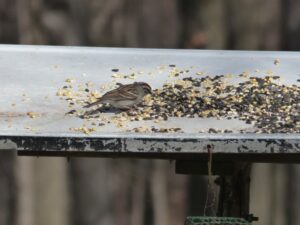
-
Eating from platform feeder
-
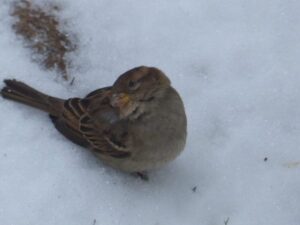
-
Thick beak of house sparrow is good for cracking corn.
Winding Pathways Asks for Help
Most people share their suburban and urban homes with plenty of House Sparrows, and moving to a wild area isn’t an option. So, what to do? Well, we listed what we do yet still have plenty of sparrows, so we’re asking for help from visitors to our Winding Pathways website. Please let us know if you’ve found a consistent and effective way to discourage this pesky bird.
Learn More
For much more information on this amazingly prolific bird go to allaboutbirds.org.
Photos by Jody Vrieze.
by Winding Pathways | Dec 14, 2023 | (Sub)Urban Homesteading, Bugs, Garden/Yard, Nature, Pests
Autumn Reveals Nature’s Wonders
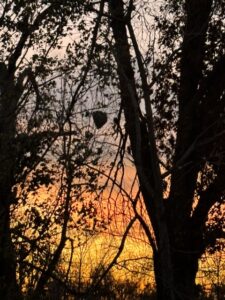
Bare trees reveal a bald-faced hornet nest.
November’s wind stripped the leaves off one of our maples and revealed a big gray football-shaped bald-faced hornet nest. Although we’d walked under it all summer, we had no clue it was there.
This fall many people will discover similar “paper wasp” nests in their trees or shrubs or even tucked near a light fixture. Made of a paper-like material, the nest was really made by insects called “bald-faced hornets” that are related to other wasps, including yellow jackets.
These social wasps can attack in droves. Their sting hurts. Because their stingers are smooth, unlike honey bees, they can sting again and again.
So, what do you do when you spot a nest on a crisp fall afternoon? Leave it alone!
Life History
The insect’s life history gives the best clue on how to avoid painful stings.
Last fall the colony of 500, or so, worker wasps died as the weather cooled. The fertile queen survived by tucking herself under a rotting log somewhere to slumber through winter. Come spring she’ll make a tiny paper-like nest, usually in a tree, and lay eggs that become workers. These hard-working new insects expand the nest and forage widely.
They are omnivores eager to dine on rotting fruit, but among their favorite foods are caterpillars and adult insects. Bald-faced hornets are a gardener’s friend, removing vegetable-chomping insects. They also sip on nectar so are good pollinators.
Aggressive or Protective?
Most sources claim they are highly aggressive, and they are if someone disturbs their nest. Several years ago, an adult neighbor spotted a nest above the doorway that the family had used all summer. He tried to knock it down and only damaged the nest. His misguided aggression unleashed an attack by dozens of upset bald-faced hornets. Stung many times, he’ll likely never again molest a nest.
We walked under and near the bald-faced hornet’s nest in our yard many times this summer and didn’t even know it was there. They didn’t attack us. Rather, they snacked on our vegetable gardens’ pests.
The lesson: leave these insects and their nest alone.
Ironically, by the time most people discover a nest in very late fall, the colony has already abandoned it. The best thing to do is NOTHING. Winter’s wind, rain, and snow will disintegrate the nest, and the queen will find a new spot to build next year’s colony.




















